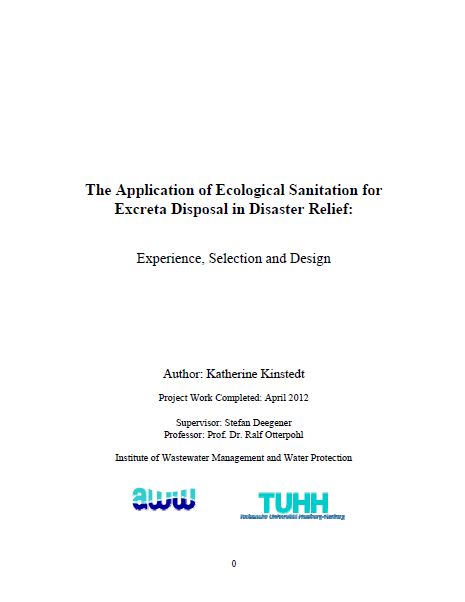The Application of Ecological Sanitation for Excreta Disposal in Disaster Relief: Experience, Selection and Design
Kinstedt, K. (2012)

Published in: 2012
Publisher:
Institute of Wastewater Management and Water Protection at Technical University of Hamburg-Harburg, Germany
Author:
Kinstedt, K.
Uploaded by:
SuSanA secretariat
Partner profile:
common upload
7972 Views
256 Downloads
Content - Summary
When responding to an emergency situation, ensuring safe excreta disposal is an urgent priority in the disaster relief effort. Aid organizations typically dig trench or pit latrines, but in some challenging environments, different methods such as ecological sanitation (Ecosan) must be employed. Ecosan is sanitation methods and technologies which promote the safe reuse rather than the disposal of excreta. Currently, Ecosan is mostly implemented in disaster relief for flood-prone areas and locations where excavation is not possible. In addition to meeting the sanitation needs of the affected population, Ecosan can be implemented to allow added benefits such as nutrient recovery, reforestation, and to help begin post-disaster recovery and the transition to peaceful and sustainable development. Several examples of disaster relief situations where Ecosan methods are employed are investigated. Statistics about these case studies are presented along with successful and
challenging aspects of the implementation. Four forms of Ecosan, urine diverting dehydration toilets (UDDT), Arborloo, biodegradable bags and composting toilets are discussed in six countries (Bolivia, Haiti, Chad, Philippines, New Zealand and Bangladesh). UDDTs had the widest extent of implementation and their flexible design makes them a good option for areas where excavation is difficult or there is a high chance of groundwater pollution (such as in flood prone regions). The composting processes offer the best success with reuse of excreta material as compost. Unfortunately though, these processes were quite complicated and do not necessary provide groundwater protection. The Arborloo provided a simpler solution with resource reuse, but this design is unfortunately not appropriate in regions where either excavation is not possible or where high groundwater is present. The Peepoo solution has shown itself to be successful in the preliminary trials, but the design still has many challenges such as cost effectiveness and user-friendliness.
In addition to exploring current case studies for Ecosan solutions, a sanitation decision flow chart is developed to compare different sanitation systems in different scenarios. In order to make a successful evaluation of the different technologies, the various design variables
affecting the design of an appropriate excreta removal system are discussed. Unfortunately, the Ecosan solutions already employed have been rather expensive and time consuming to construct and/or they do not provide adequate groundwater protection. Additionally, there is a need to increase the portability of the sanitation solutions to increase the ease of access for disabled and elderly people as well as ensure that more women and children have access to sanitation option at the household level to decrease the security risk of nighttime toilet use. To respond to these needs, a rapidly deployable and inexpensive Ecosan solution has been proposed, the Porta Preta. The proposed solution uses Terra Preta Sanitation in an inexpensive, simple and portable design, providing some hygienization of the waste, significantly reducing odors, and facilitating the reuse of the urine and the excreta. To achieve these objectives, the separate collection of urine and feces is incorporated into the design. The urine is diverted and both the feces and the urine under go a lactofermentation process. Biochar is added also to the feces to eliminate odor and facilitate the reuse of the excreta as a soil additive. The design, costs, logistics and expected challenges of the Porta Preta are discussed in this report. Fixed costs would be approximately $70 for the first month of operation serving a household of five individuals. The monthly cost would be approximately $0.80 per user per month.
Supervisors: Stefan Deegener & Professor Ralf Otterpohl
Bibliographic information
Kinstedt, K. (2012). The Application of Ecological Sanitation for Excreta Disposal in Disaster Relief: Experience, Selection and Design. Institute of Wastewater Management and Water Protection at Technical University of Hamburg-Harburg, Germany
Filter tags
Composting, vermicomposting (solid waste), composting toilets English Urban informal settlements (slums) Urine diversion dehydration toilets (UDDTs)















